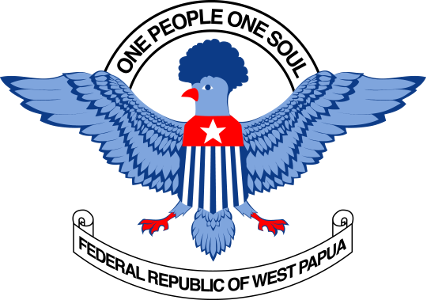ULMWP MEDIA STATEMENT, 1 April 2020
What’s going on in West Papua behind COVID-19?
On Tuesday 31 March 2020, a man in a shadowy photo apparently walked out of West Papua’s airport in Sentani, fell over, and died. He isn’t Papuan, but there shouldn’t have been any flights anyway. The Jakarta government had over-ridden Governor Enembe’s closure of the province, and threatened him with legal action for usurping central government authority. It had also ignored calls from Dominikus Surabut, Chair of the Papua Customary Council, to halt flights after Jakarta Post (25 March) reported on the first COVID-19 death (in Sorong) as well as 7 COVID patients, with 19 more under observation (6 in Merauke, 2 in Biak, 1 in Mimika, 10 in Jayapura). On 31 March Jakarta finally declared a ‘public health emergency’ and ordered the National Police to enforce (unknown) restrictions.
Recently photos have surfaced of thousands of Papuans in Mimika abandoning their villages as the Indonesian military implements Defense Minister Prabowo Subianto’s promise to exterminate the West Papuan Army and extinguish the people’s independence movement. This most recent military campaign has been raging since December 2018 when the Indonesian Air Force dropped bombs of the banned chemical white phosphorous on highland villages in Nduga, killing 243 civilians (including ten children) and displacing 50,000 Papuans who have since survived under plastic sheets in Wamena.
Ironically, it was fifty-seven West Papuans were charged with treason—not the Indonesian Parliament and its Army, Airforce, and intelligence agencies for gross human rights violations. The West Papuan Army has been defending its citizens and homeland since 1 May 1963 when the United Nations succumbed to Indonesian military aggression and handed over the then Non-Self-Governing Territory. Under numerous presidents Indonesia has failed to govern the territory responsibly or sustainably. Special Autonomy since 2001 has failed spectacularly. Structured by Jakarta for ‘national security’ not ‘local autonomy’, it has been an engine for the exponential growth of military infrastructure and personnel, and West Papuans are still at the bottom of Indonesia’s human development index. Furthermore they are calculated to become, by 2030, just 15% of the population; dropping from 99% in 1962, to 30% in 2010, with a growth rate of 1.6% compared to the non-Papuan rate of 10.5%.
The Jokowi Government’s refusal to meet ULMWP executives is irrational, given that its own state legislature in Jayapura, and all the Papuan churches, have advised it opens a dialogue with the influential political organization which in 2019 won the support of the African Caribbean Pacific Group of 79 UN-member-states and the Pacific Islands Forum (which includes Australia and New Zealand). The ULMWP is seeking peace talks based on the UN principles employed most recently in East Timor, New Caledonia, and Bougainville.
Jacob Rumbiak, Spokesperson, United Liberation Movement for West Papua
